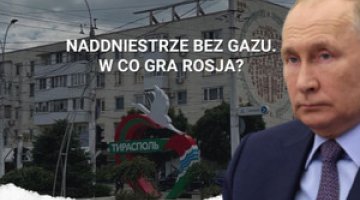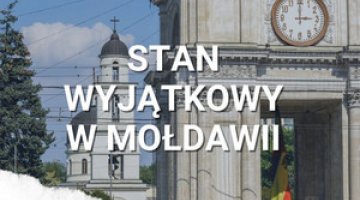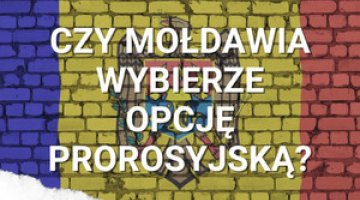Separatism and gas: Russian attempts to destabilise Moldova

As the price crisis in Moldova has worsened in recent months, Moscow has taken steps to destabilise the country. These are particularly evident in the autonomous Gagauzia, which has traditionally orientated itself towards Russia and where anti-government and pro-Russian economic protests regularly occur. The sense of insecurity is reinforced by frequent false bomb warnings (more than 50 in July alone), triggered mainly in Chisinau by individuals from Russia and Belarus territories. The uneasy situation persists in Moscow-controlled breakaway Transnistria, which has accused Moldova and Ukraine of complicity in carrying out a series of "attacks" on civilian and military facilities.
There is no doubt that by fuelling Moldova's economic crisis with high energy prices and supporting pro-Russian forces, the Kremlin is counting on the outbreak of mass protests as early as autumn and winter and also that the opposition Electoral Bloc of Communists and Socialists (BECS) will seize power in the country. The public's deteriorating financial condition and continuing unrest are negatively affecting the popularity of the ruling pro-European Party of Action and Solidarity (PAS). According to a June 2022 poll, it can count on only 22.6% of the vote,[1] despite winning more than 52% in the snap parliamentary election just one year ago.
Tensions in Gagauzia…
Rising food[2] and energy[3] prices have been met with particularly strong discontent in Moldova's southern Gagauzian Autonomous Unit – the poorest region of the country, inhabited mostly by the pro-Russian Gagauz people – an Orthodox minority with a Turkic language but who regularly speak Russian. As a result, regular but relatively small anti-government protests have been taking place in the region's major cities for several months. Although they are primarily concerned with social issues, they also have a clear pro-Russian character. The protestors criticise, among other things, the ban on the use of the "Ribbon of Saint George" (which, like the letters "V" and "Z", was considered a symbol inciting war) in public spaces, which was introduced in April by the central authorities.[4] The end of July saw the establishment of the People's Union of Gagauzia (Gagauz Halk Birlii), which is an anti-government socio-political movement aimed at protecting the rights and freedoms of the region's residents, improving its position in the structure of the Moldovan state and developing "good relations with Russia and other countries of the Eurasian Economic Union". The grouping openly criticises the pro-European government in Chisinau – calling them "Russophobic" and accusing them of triggering "catastrophic price increases" and pursuing "anti-national and anti-state policies" aimed at "distancing Moldova from Russia." Its leader is Victor Petrov, a deputy of the People's Assembly (Halk Topluşu), i.e. the local parliament. According to some commentators, Petrov may have financial ties to Russia[5] Among other things, he founded the Centrul Comunitar Anticriză organisation, which includes the gagauznews.md news site, which was blocked by Moldova's Information and Security Service (SIS) after the Russian invasion of Ukraine for promoting content inciting hatred and war. In early February, Petrov said that he and several other MPs had sent a letter to President Vladimir Putin, Kremlin deputy head of administration Dmitry Kozak and Gazprom head Alexei Miller, asking that humanitarian aid be provided to Gagauzia in the form of gas supplies free of charge or at a lower price than for the rest of Moldova.[6]
Russian media outlets have widely publicised the establishment of the People's Union of Gagauzia and have consistently reported on subsequent demonstrations in the region. Russian politicians have been critical of Chisinau's attitude towards Gagauzia – including the head of the Duma Committee on International Affairs, Leonid Slutsky, who supported the minority protests, accused the central authorities of "violating the rights of Gagauzians," and threatened them that "they are going down a very dangerous path".[7] It is in the Kremlin's interest for Gagauz groups to receive support from the Russian government and media. These groups are pro-Russian, critical of their government and are exploiting growing popular discontent to achieve their goals. The possible offer of cheaper gas to Gagauzia will provide an additional, important argument for the increased importance of these groups. Chisinau's almost certain refusal could stoke already heightened tensions between the central government and Gagauzia. The region – in the wake of rising separatist sentiment and fear of Moldova merging with Romania – declared itself an independent republic (within the Soviet Union) back in 1990. It was not until four years later that Comrat recognised Chisinau's sovereignty and acceded to the creation of the Gagauz Autonomous Unit within the Republic of Moldova.[8] Since then, local politicians have regularly criticised the republican authorities for ignoring its interests or limiting its rights. The dispute traditionally intensifies when pro-European groups take power in Chisinau. One glaring example of the tensions between the central authorities and Comrat was in 2014 when Gagauzia organised – in defiance of Moldova, and in response to its planned signing of an association agreement with the EU – a referendum in which 98.5% of voters voted in favour of the country's integration into the Customs Union. The initiative was supported by Russia from the beginning, and the event itself was observed by Russian government representatives.[9]
…and "attacks" in Transnistria
The Russian government is also seeking to maintain tensions in the separatist Transnistria, which is politically and financially dependent on Russia, and where its troops have been stationed since the early 1990s.[10] After the invasion of Ukraine, the question of whether these forces could be used on Ukrainian territory or used to increase unrest in the region was on the agenda. Potentially, they could assist the operation to seize the south of Ukraine and create a land connection with a self-proclaimed republic. The fact that these plans failed does not mean that the Kremlin does not intend to maintain a tense atmosphere around Transnistria. This is demonstrated by incidents allegedly indicating that it is vulnerable to aggressive military action by Ukraine and Moldova, supposedly seeking to seize control of it. According to the Transnistrian authorities, on 25 April, a building of the so-called Ministry of State Security in Tiraspol was fired upon with hand grenade launchers, and an unidentified drone allegedly dropped two explosive devices on a local airport. Explosions were also reported on the grounds of a military unit in the town of Parcani. A day later, a series of explosions destroyed two relay masts transmitting the signal of Russian radio stations in the village of Maiac. For the next few days, local media reported on unmanned aerial vehicles that appeared in the vicinity of post-Soviet ammunition depots in the town of Cobasna, near the Ukrainian border.[11] On 26 April, the highest ("red") terrorist threat level was introduced in Transnistria. In mid-May, the separatist authorities reported "attacks" on a fuel depot and a military replenishment command,[12] and a few days later accused a Moldovan special services officer of the latter attack.
Although the situation has recently calmed down somewhat (the "red" threat level was replaced by "yellow" at the end of May), incidents "provoked", according to Tiraspol, by Moldova or Ukraine still occur. At the end of July, local media reported that Transnistrian services had detained a Ukrainian citizen who was alleged to have purchased the uniforms of so-called border guards and smuggled them into his homeland in order to "organise incitement and discrediting." Propaganda messages also included reports of Romania allegedly preparing the annexation of Moldova. Tensions between Tiraspol and Chisinau are also being built up by statements made by the leadership of the para-state, such as the July 22 declaration by the head of the so-called Transnistrian Foreign Ministry, Vitaly Ignatyev, of a desire for the unrecognised republic to join Russia. This is nothing new – the intention for such integration has been part of Tiraspol's "official" political line since the 1990s – but in the context of the ongoing Russian-Ukrainian war it takes on new undertones.
Both Chisinau and Kyiv reject accusations coming from Tiraspol of involvement in organising attacks on Transnistrian institutions. It seems certain that the incidents that have taken place there in recent months occurred at the inspiration of Russia and with its complicity, and were in its interest. The alleged attacks confirm the Kremlin's repeated propaganda thesis of possible pre-emptive Ukrainian "aggression" against Transnistria, or its annexation by Romania, acting "on behalf of" the United States. The escalating situation in the unrecognised republic and rumours of the use of armed forces there are forcing Kyiv to keep troops near the border with Moldova. Accusing it of preparing attacks on Transnistria – or even sanctioning them to happen – allows Russian propaganda to present Ukraine as a state that resorts to terrorism. The series of "attacks," allegedly carried out by Ukrainians and Moldovans, is designed to stoke sentiments of hostility among residents towards their neighbours and to make them recognise Moscow as the only guarantor of security.
The use of Russian forces stationed in Transnistria for combat operations in Ukraine seems unlikely primarily because they cannot count on supplies of reinforcements and logistical support from Russia. This does not mean, however, that they will not be involved in sabotage on Ukrainian territory to tie down the army there. In the case of Moldova, their presence and increased activity is expected to heighten fears among the population about the possibility of Chisinau being drawn into open armed conflict.
Impending energy crisis
The tensions in Transnistria and Gagauzia are occurring against the backdrop of an increasingly clear Moldovan-wide energy crisis, which will only worsen in the coming months. Kremlin policy is among the more significant sources of problems.[13] The autumn and winter heating season will bring particular difficulties – the associated increase in gas consumption will almost inevitably force further tariff increases and worsen the financial situation of citizens. Moldovagaz – the country's gas operator – has already announced the suspension of supplies to defaulting customers. In order to destabilise the social situation in Moldova, Moscow may decide to stop the transmission of gas, citing Chisinau's violation of the terms of the contract. In the contract, which was concluded at the end of 2021, the authorities in Chisinau pledged to audit the operator for its debts and to sign an agreement by May 1 to settle them. Gazprom says the company owes it about $700 million. According to Infrastructure and Regional Development Minister Andrei Spînu, Russia's onslaught against Ukraine has prevented a tender to select an auditor and, as a result, the Moldovan side has requested the audit be postponed. Failure to fulfil its obligations gives Gazprom the right to interrupt the supply of gas at virtually any time. Another pretext for withholding supplies may be Moldovagaz's inability to pay its ongoing obligations to Gazprom. As recently as last year, Gazprom threatened to halt gas shipments in such a situation.In early August the director of this Moldovan company said that it will not be able to pay Gazprom on time (this problem will recur in the following months).[14]
Once the tap is turned off, the country would be forced to purchase gas on an ad hoc basis on spot markets, which entails high prices and the need to pay upfront. The likelihood of this scenario is difficult to assess – Russia may be holding back, as cutting off supplies to Moldova will also hit Transnistria. Nevertheless, Chisinau is already preparing for this eventuality. In July, the parliament ratified a loan agreement with the EBRD giving access to €300 million that Moldova will be able to use to purchase gas. In turn, under an agreement with Romania, the country is using underground storage facilities there, where it holds a reserve of about 25 million cubic metres of gas (which covers about 2.5% of annual domestic demand). In December 2021 and August 2022, Chisinau also received two tranches of financial assistance from the EU (€60 million and €75 million, respectively), intended to mitigate the effects of the energy crisis, i.e. to cover part of the cost of rising electricity prices.
The possible interruption of gas supplies from Russia will also lead to electricity supply problems. Its main supplier is the Moldavskaya GRES power plant, located in Transnistria and owned by the Russian company Inter RAO UES, which generates up to 70-80% of the electricity consumed in the country. This power plant is powered by gas supplied from Russia, so it will not be able to continue operating if supplies are halted. In this situation, Moldova, which on its own covers only 20% of its internal demand, will be forced to import electricity from alternative sources, namely Ukraine or, more recently, Romania (thanks to the March 16 synchronisation of the Moldovan and Ukrainian power grids with Europe's ENTSO-E). However, the energy obtained in this way will be tangibly more expensive.[15] An additional problem for imports from these directions may be the fact that the country's main electricity hub is located on and controlled by Moldavskaya GRES.
Outlook
Moldova's socio-economic crisis is likely to worsen in the autumn and winter due to high energy prices. This could lead to mass anti-government protests not only in Gagauzia, but also in the rest of the country. The organisers themselves have announced that they will prepare a demonstration in Chisinau by 27 August – Moldova's Independence Day.[16] While the compensation mechanisms planned by the government will mitigate the effects of energy price hikes, they are likely to cover only a portion of the population and will not stop further declines in support for the government. In the event that the country is cut off from Russian supplies and has to purchase gas at high spot prices, the existing financial support from Western partners is likely to prove far from sufficient and will have to be increased.
Although the collapse of the current cabinet seems highly unlikely (PAS has an absolute majority in parliament and Maia Sandu, who came from this grouping, sits as president), Russian-backed anti-government forces in Gagauzia may start raising economically-motivated separatist slogans and calling on Moscow for assistance. In the most extreme case, this could mean sending informal support to the region from Transnistria as part of hybrid operations. Open involvement of Russian troops on the right bank of the Dniester, on the other hand, should be considered almost out of the question since, without seizing the Odesa region, Moscow will not be able to provide them with assistance. At the same time, it is not clear how Chisinau would react to diversionary moves.[17] The situation in Transnistria will remain tense, possibly serving as an additional pretext for Russia to take action in Moldova or Ukraine.
[1] ‘SONDAJ iData // PAS pierde tot mai mulți alegători iar Partidul „Șor” ar crește în popularitate’, Paranteze.MD, 29.06.2022, paranteze.com.
[2] In May, food prices rose (year-on-year) by 32.5%, services rose by 35.27%, and non-food products by 21.45%. In an effort to combat inflation, the National Bank of Moldova increased interest rates fourfold, which hit borrowers there. See ‘Rata anuală a inflației’, National Bank of Moldova, bnm.md.
[3] While the price of gas for residential consumers was L4.64 (about $0.23) per cubic metre in October 2021, it increased fivefold in August, reaching nearly L23 ($1.2).
[4] In response to the introduction of a ban on the use of the “Ribbon of Saint George" in public spaces, among other things, the Gagauz People's Assembly (i.e., the Gagauz Parliament) passed a law in May allowing its display (as well as other "symbols of victory") on the territory of Gagauzia. From a constitutional point of view, it had no legal force (as it contradicted the national law) and it became the subject of a dispute with Chisinau.
[5] G. Carasiucenco, ‘Cine este Victor Petrov din Găgăuzia și de ce ar putea fi periculos pentru securitatea Republicii Moldova’, Moldova.org, 3 August 2022.
[6] Е. Дубасова, ‘Депутаты Гагаузии написали Путину. Они просят бесплатный газ для автономии’, NewsMaker, 8 February 2022, newsmaker.md.
[7] ‘В Госдуме России назвали действия властей Молдовы “ущемлением прав гагаузского народа”’, Аргументы и Факты в Молдове, 4.08.2022, aif.md.
[8] K. Całus, ‘Gagauzia: growing separatism in Moldova?’, OSW Commentary, no. 129, 4 March 2014, osw.waw.pl.
[9] More in: ibid.
[10] The strength of the Russian contingent in Transnistria is estimated at 1,500 troops. If necessary, they can work alongside some 2,500 to 5,000 local military formations.
[11] On April 26, the so-called president of Transnistria, Vadim Krasnoselsky, said that investigators explaining the circumstances of the incidents indicate that Ukraine is behind them.
[12] ‘В столице Приднестровья попытались поджечь нефтебазу и военкомат’, Коммерсантъ, 13 May 2022, kommersant.ru.
[13] In addition to maintaining high gas prices, Moscow is also trying to hit Moldova's agricultural sector. On 15 August it imposed an embargo on imports of local fruits and vegetables.
[14] ‘Vadim Ceban: Moldovagaz nu va putea plăti pentru gazul rusesc în luna august’, Realitatea Din Moldova, 10 August 2022, realitateadinmoldova.md.
[15] While Moldova pays Moldavskaya GRES about $60 per MWt in August, it costs $77 in Ukraine and €361 in Romania.
[16] ‘Организатор протестов в Комрате: Власть нас не слышит, мы идем в Кишинев’, Point.md, 14 August 2022.
[17] On August 18, in Gagauzia’s capital, Comrat, Moldova's Fulger special police unit conducted an anti-terrorism drill, which anti-government circles and Russian propaganda saw as a demonstration of force by the authorities in Chisinau. ‘Principalul agitator al Moscovei agită spiritele din nou: Republica Moldova ar fi trimis o brigadă ”Fulger” în Găgăuzia’, Știrile ProTV, 18 August 2022, stirileprotv.ro.




